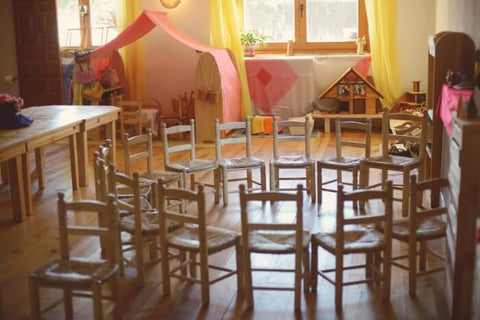Waldorf vs Montessori Education: What's the difference?

Waldorf and Montessori schools are two popular types of schools for preschool and elementary school age children. However, some parents aren't sure what the differences and similarities are between the two schools.
Dr. Maria Montessori, a medical doctor and anthropologist, opened the first Casa dei Bambini (not “school” but “house of children”) in Rome, Italy in 1907.
Rudolf Steiner founded the Waldorf School at Stuttgart in Germany in 1919 for the children of the factory workers of the Waldorf Astoria Cigarette Company at the request of that company's director.
Waldorf vs Montessori Comparison
|
Montessori |
Waldorf |
|
|
Year Founded |
1907 |
1919 |
|
Developed in |
Italy |
Austria |
|
Age groups |
0-12 Years |
0-7 Years |
|
Self Guided |
Yes |
Yes/No |
|
Project-based approach |
Yes |
No |
|
Forward-thinking approach |
Yes |
Yes |
|
Sensorial play |
Yes |
Yes |
Curriculum Differences

In Waldorf schools the academic subjects are kept from children until a much later age than Montessori.
They are thought to be, as in traditional schools, something necessary but not especially enjoyable, and best put off as long as possible. The day is filled with make-believe, fairies, art, music and generally the arts, putting off reading, writing and math until age seven or so.
Dr. Montessori on the other hand, filled her first school of 3-6-year-olds with dolls and other traditional make-believe toys but found that when children were given the opportunity to do real work such as cooking, cleaning, caring for themselves, each other, and the environment, they completely lost interest in make-believe and preferred real work.
She later invented manipulative language, math, and other academically-oriented materials and studied the children’s response. Academic lessons were, and are now, never required or forced, but offered to and enjoyed by the children.
Curriculum Similarities

Montessori and Waldorf both recognize and respect a child's need for rhythm and order in his daily routine. They recognize that need in different ways. For example, Dr. Montessori felt that children shouldn't just play but should play with toys that will teach them concepts.
Also Read: How to Choose the Perfect Montessori Calendar in 7 Easy Steps
Montessori schools use Montessori designed and approved toys, while Waldorf encourages the child to create their own toys from materials that happen to be at hand.
Both Montessori and Waldorf use curriculums that are developmentally appropriate. Both approaches believe in a hands-on as well as an intellectual approach to learning and both also work in multi-year cycles when it comes to child development.
However, Montessori uses six-year cycles, while Waldorf works in seven-year cycles.
Also Read: How Much Does Montessori School Cost?
Both Montessori and Waldorf believe in developing the whole child, teaching children to think for themselves, and, above all, showing them how to avoid violence. These are beautiful ideals that will help build a better world for the future.
Montessori and Waldorf use non-traditional methods of assessments. Testing and grading are not part of either methodology.
Fantasy and Imagination

The Waldorf philosophy is that play is viewed as the work of the young child and the magic of fantasy. It is an integral part of how the teacher works with the child.
The teacher incorporates storytelling and fantasy into the curriculum. The child can use for the most part any of the materials in any way.
In Montessori fantasy and imagination are very much a part of the creative process. However, since the real world is seen as a wonderful creation as it is, children are introduced to the real world in all is variations in the first six years, and then use these experiences to create for the rest of their lives.
Also Read: The 15 Best Montessori Books
The word “work” is used to describe the child’s activities instead of “play” because they as respected as adult activities.
Method

The early development years, in Waldorf, utilizes activities that are most often taught and carried out in groups with the teacher leading.
When academic subjects are studied, they are taught in a more traditional way, the teacher talking, the children at desks being taught in a group.
Children are kept together with a group of children their own age with the teacher ideally moving up each year with the children and so getting to know and working with the same group of children for six years. Arts are ideally always a part of the academic studies.
In Montessori, social development is more like real life because children are not kept in groups of the same-age students, but are grouped in 3 to 6 year age span.
Also Read: The Pros and Cons of the Montessori Method
The teacher gives lessons individually to one child at a time, and usually lessons are given to one child by another child. The choice of what to study or work on at any one time is left to the child, with guidance whenever necessary by the teacher.
A high level of creativity is reached because the children's experience is based on rich experience in the real world and the exact use of materials.
Children learn exact techniques for many of the materials, just as they would learn the exact use of a piano or a violin, each experience considered a “key” which opens a new door of understanding and experience.
This use of materials has been taught to the adults, adapted whenever necessary, through the direct and continued observation of children all over the world over the last 100 years.
Conclusion
The progressive approaches that Montessori and Waldorf style teaching offers young children have been tried and tested for almost 100 years.
They have many things in common, as well as several differences. When comparing Montessori and Waldorf with traditional preschools and kindergarten classes, you will see even more differences.
